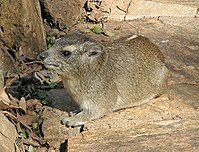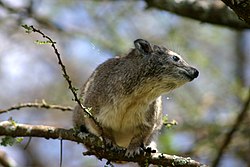Hyrax
| Hyraxes Temporal range: [citation needed]
| |
|---|---|

| |
| Heterohyrax brucei | |
| Scientific classification | |
| Kingdom: | |
| Phylum: | |
| Class: | |
| Infraclass: | |
| Superorder: | |
| Order: | Hyracoidea Huxley, 1869
|
| Family: | Procaviidae Thomas, 1892
|
| Genera | |
A hyrax (from Greek ὕραξ "shrewmouse") is any of four species of fairly small, thickset, herbivorous mammals in the order Hyracoidea. They live in Africa and the Middle East.
Hyraxes are well-furred rotund creatures with a mere stump for a tail. They are about one-third the size of a Corgi; most measure between 30-70 cm long and weigh between 2-5kg. From a distance, a hyrax could be mistaken for a very well-fed rabbit or guinea pig.
Characteristics

Hyraxes retain a number of early mammalian characteristics; in particular they have poorly developed internal temperature regulation (which they deal with by huddling together for warmth, and by basking in the sun like reptiles). Unlike other browsing and grazing animals, they do not use the incisors at the front of the jaw for slicing off leaves and grass, and use the molar teeth at the side of the jaw instead. The incisors are nonetheless large, and grow continuously through life, in a similar manner to those of rodents. There is a short diastema between the incisors and the cheek teeth. The dental formula for hyraxes is:1.0.4.32.0.4.3
Unlike the even-toed ungulates and some of the macropods, hyraxes do not chew cud to help extract nutrients from coarse, low-grade leaves and grasses. They do, however, have complex, multi-chambered stomachs that allow symbiotic bacteria to break down tough plant materials, and their overall ability to digest fibre is similar to that of the ungulates. They will show antagonistic behavior, such as making chewing motions, when they feel threatened. This behavior is often times confused with chewing cud.[1] There are reports that the Hyrax can chew regurgitated food, however, this is infrequent and they do not do this for nutrition or as part of their diet. [2]
Hyraxes inhabit rocky terrain across sub-Saharan Africa and the Middle East. Their feet have rubbery pads with numerous sweat glands, which help the animal maintain its grip when moving fast up steep rocky surfaces. They also have efficient kidneys, retaining water so that they can survive in arid environments.
Female hyraxes give birth to up to four young after a gestation period of between seven and eight months, depending on the species. The young are weaned at one to five months of age, and reach sexual maturity at sixteen to seventeen months. Male hyraxes have testicles that do not reside in the scrotum, much like elephants, manatees and dugongs.
Hyraxes live in small family groups, dominated by a single male who aggressively defends the territory from rivals. Where there is abundant living space, the male may dominate multiple groups of females, each with their own range. The remaining males live solitary lives, often on the periphery of areas controlled by larger males, and mate only with younger females.[3]
Historical accounts

The word "rabbit, or "hare" was used instead of "hyrax" many times in some earlier English Bible translations. European translators of those times had no knowledge of the hyrax (Hebrew שָּׁפָן Shaphan[4]), and therefore no name for them. There are references to hyraxes in the Old Testament[5] particularly in Leviticus 11, where they are described correctly as lacking a split hoof. It also details that the hyrax chews its cud and is thus not kosher, however, this observation is due to the habit of the hyrax chewing without having ingested anything, resembling the chewing of cud (the hyraces studied by the Hebrews may have been in captivity).[6] Some of the modern translations refer to them as rock badgers. Shaphan was also the name of a scribe of King Josiah.
Phoenician sailors visiting the coast of Spain circa 1100s BC, mistaking the European rabbit for the rock hyrax Procavia capensis from their native homeland, gave it the name i-shepan-ham. A theory exists that a corruption of this name, used by the Romans, became the Latin name for Spain, Hispania --- although this theory is somewhat controversial[7].
Evolution
Hyraxes are sometimes described as being the closest living relative to the elephant.[8] This is because they may share an ancestor in the distant past when hyraxes were larger and more diverse. However, the details of their taxonomic relationship remain to be fully verified.
All modern hyraxes are members of the family Procaviidae (the only living family within the Hyracoidea) and are found only in Africa and the Middle East. In the past, however, hyraxes were more diverse and widespread. The order first appears in the fossil record over 40 million years ago, and for many millions of years hyraxes were the primary terrestrial herbivore in Africa, just as odd-toed ungulates were in the Americas. There were many different species, the largest of them about the weight of a small horse, the smallest the size of a mouse. During the Miocene, however, competition from the newly-developed bovids—very efficient grazers and browsers—pushed the hyraxes out of the prime territory and into marginal niches. Nevertheless, the order remained widespread, diverse and successful as late as the end of the Pliocene (about two million years ago) with representatives throughout most of Africa, Europe and Asia.
The descendants of the giant hyracoids evolved in different ways. Some became smaller, and gave rise to the modern hyrax family. Others appear to have taken to the water (perhaps like the modern capybara), and ultimately gave rise to the elephant family, and perhaps also the Sirenians (dugongs and manatees). DNA evidence supports this hypothesis, and the small modern hyraxes share numerous features with elephants, such as toenails, excellent hearing, sensitive pads on their feet, small tusks, good memory, high brain functions compared to other similar mammals, and the shape of some of their bones.[9]
Although relatively closely related, not all scientists support the proposal that hyraxes are the closest living relative of the elephant. Recent morphological and molecular based classifications reveal the Sirenians to be the closest living relatives of elephants, while hyraxes are closely related but form an outgroup to the assemblage of elephants, sirenians, and extinct orders like Embrithopoda and Desmostylia.[10].
List of extinct species
Living species
Scientists have recently reduced the number of distinct species of hyrax recognized. As recently as 1995 there were eleven or more recognized species; only four are recognized today. The remaining species are regarded as subspecies of the remaining four. There are over 50 recognized subspecies and species, many of which are considered highly endangered.[11]
- ORDER HYRACOIDEA
- Family Procaviidae
- Genus Dendrohyrax
- Southern Tree Hyrax, Dendrohyrax arboreus
- Western Tree Hyrax, Dendrohyrax dorsalis
- Genus Heterohyrax
- Yellow-spotted Rock Hyrax, Heterohyrax brucei
- Genus Procavia
- Rock Hyrax, Procavia capensis
- Genus Dendrohyrax
- Family Procaviidae
References
This article needs additional citations for verification. (July 2007) |
- ^ http://www.zootorah.com/hyrax/hyrax.pdf
- ^ 72891 HENDRICHS, H. Vergleichende Untersuchung des wiederkauverhaltens [ Comparative investigation of cud retainers] BIOL ZENTRALBL 84 (6): 671-751 Illus. 1965 [ recd.1966]. "All artiodactyl families and about 80% of the spp. were investigated. Chewing regurgitated fodder is an idle pastime as well as an instinct associated with appetite. Characteristic movements were analyzed for undisturbed samples of animals maintained on preserves. Group specific differences are reported in form, rhythm, frequency and side of chewing motion. The ungulate type is characterized as a specialization. The operation is described for the first time for the order Hyracoidea. On the basis of 12 spp. of the marsupial subfamily Macropodinae rumination is inferred for the whole category. Advantages of the process are debated."
- ^ Hoeck, Hendrik (1984). Macdonald, D. (ed.). The Encyclopedia of Mammals. New York: Facts on File. pp. 462–465. ISBN 0-87196-871-1.
- ^ "Shaphan" in Strong's Concordance
- ^ Lev 11:4-8; Deut 14:7; Ps 104:18; Prov 30:26
- ^ http://www.zootorah.com/hyrax/hyrax.pdf
- ^ Anthon, Charles. A System of Ancient and Mediæval Geography for the Use of Schools and Colleges pg.14
- ^ "Hirax Song is a Menu for Mating". 15 January 2009. Retrieved 15 January 2009.
{{cite web}}: Unknown parameter|Work=ignored (|work=suggested) (help) - ^ "Hyrax: The Little Brother of the Elephant", Wildlife on One, BBC TV.
- ^ Asher, R.J., Novacek, M.J., Geisher, J.H. (2003). "Relationships of endemic African mammals and their fossil relatives based on morphological and molecular evidence". J. Mamm. Evol. 10: 131–194. doi:10.1023/A:1025504124129.
{{cite journal}}: CS1 maint: multiple names: authors list (link) - ^ Shoshani, J. (2005). Wilson, D.E.; Reeder, D.M. (eds.). Mammal Species of the World: A Taxonomic and Geographic Reference (3rd ed.). Johns Hopkins University Press. pp. 87–89. ISBN 978-0-8018-8221-0. OCLC 62265494.
